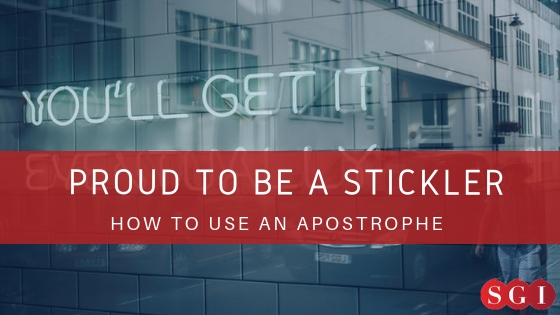
Do you have doubts about using punctuation marks? Do you sometimes put them in the wrong position, or avoid using them altogether? If so, you re not alone; many people find punctuation difficult to navigate, especially when the same symbols might vary in usage across different languages. However, it is important to get it right: correct punctuation will help make your writing clear and effective and will make it easier for the reader to understand what you want to express. Accurate punctuation is paramount in academic and work contexts because even the odd error can impact on how professional your writing appears to the reader.
In this article we take a look at the humble apostrophe, its two main functions and some common errors students make with misplacing or missing it out. The origin of the word apostrophe is a Greek word meaning turn away , which denotes its first job indicating that letters have been omitted. The second use of the apostrophe is to show possession i.e. the relationship between things and/or people. Below we examine these two key functions with examples.
Omission
An apostrophe is used to show that something (usually letters) is missing. I m sure you are already familiar with how this applies to verbs in the case of contracted forms:
I am = I m
You were not = You weren t
She did not = She didn t
They could have = They could ve
Years can also be shortened in the same way:
1982 = 82
The apostrophe is also a common feature of informal texts, in particular song lyrics:
because = cause
doing = doin
Finally, if you re ever wondered why we tell the time the way we do
five of the clock (no longer in use) = five o clock
Possession
To show a relationship of belonging between someone and another person or thing, the apostrophe plus s is usually used:
She s Linda s cousin.
That s Helen s car.
Are you going to Jack s party?
The same is true for some singular nouns:
The website s popularity has grown.
My cat s tail twitched.
Likewise with plural nouns that do not end in s :
The women s shoes are over there.
Can you pass me the children s jackets?
Names that end in s should be followed by an apostrophe and a second s :
Have you been to St. James s park?
I met Charles s partner yesterday.
However, you might come across exceptions to this rule:
She was admitted to St. Thomas hospital.
Simply putting an apostrophe after the s is how the possessive of plural nouns ending in s is formed:
The students questions were answered.
We replaced the cats toys.
Common errors
- Its v It s
Its is a possessive adjective and does not take an apostrophe and must not be confused with the contracted form of it is :
I bought a new mobile but it s its screen cracked the first day I got it.
It is a lovely day today. = It s a lovely day today.
- Using apostrophes in plural forms
Don t be tempted to use the apostrophe plus s to make a plural form of a noun, abbreviation or number:
I was born in the 1980 s 1980s.
The CEO s CEOs met at the conference.
The exception would be when forming the plurals of singe letters and numbers:
How many e s are there in this sentences?
All the 2 s sit together.
S.L.L.

